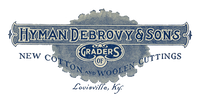About Us
About DeBrovy's
Masters of the Undercover
We offer the widest selection of manufactured tarps for different uses, in the country. For that reason, we have a selection of over 150 fabrics with different widths and lengths. Most products are made to order. Back in the 1960's thru the 1990's we used to make and sell canvas tarps, we sold so many we stocked about 20 different sizes. That business dried up when synthetic fabrics came out.
A canvas tarp is a natural cotton canvas product, vs. a vinyl tarp is considered a synthetic material. Plastic is the coating applied to the scrim (base inner fabric) , its also known as PVC (poly vinyl chloride) or PVC for short. When vinyl tarps were first introduced, nylon was the standard substrate. Nylon is very durable and it was sandwiched between two layers of vinyl or PVC. Then as the price of nylon increased, polyester replaced it and was far less expensive. Vinyl coated nylon is still around but is pretty cost prohibitive, it is still used by the military. One military application are tents. Based on our experience and years in the industry, 95% of vinyl tarps in the U.S. are vinyl coated polyester. To the lay person, they don't know the difference. We switch from nylon to polyester basically when the polyester became the new industry standard.
The reason we stock and make tarps to order, is because there are so many sizes and options to choose from when selecting a tarp. One good example, do you want webbing sewn in the hem, a triple rolled hem or can we fold the material over once and sew it. We at DeBrovys, triple roll our hems, which means there are 3 layers of fabric in the hem. Triple rolling the hem is the standard in the industry, and does not mean that every manufacturer does it. If your not sure, ask your tarp manufacturer. Another example or option in a tarp, is it made cut size or finished size. The industry standard is cut size, and may see C/S after the size. The cut size tarp usually finishes 3-5% less, if the hems are triple rolled. This allows approximately 3 inches of the fabric to be taken up per side of the tarp. The finished size is exactly that, the size you may think you are getting. One reason you may need to specify finished size when ordering, the cover may need to fit exactly in a window. The industry standard is cut size. If you go into any big box store that stocks blue plastic tarps, you will see in large letters the size followed by c/s, which stands for cut size. Below the size on the tarp's paper insert, will be the actual size or finished size spelled out or in parentheses. We at DeBrovys follow the standard, cut size, unless stated otherwise. It goes without saying, when producing a cut size tarp, it cost less than finished size. If your not sure of which you have, ask your tarp manufacturer.
Production times may vary. Generally we quote production times to be 10-15 business days. Some say that is a long time. What we are not telling you is, all the things that go on behind the scenes when we take your order. When dealing with employees, the name of the game is keeping them busy at all times, and that means knowone standing around waiting for work. Secondly, someone is in charge of making sure all the components that go into making a tarp are in stock. Those items include; fabrics and the right widths, grommets in the right size, shapes, and thicknesses. Grommets used in the tarp industry are metal, brass or stainless steel. We at DeBrovys use brass grommets. Webbing used in tarps are; polypropylene, nylon (seatbelt), or cargo. We at DeBrovys use all 3 types, all for different applications. Webbing comes in different widths, thicknesses and colors.
